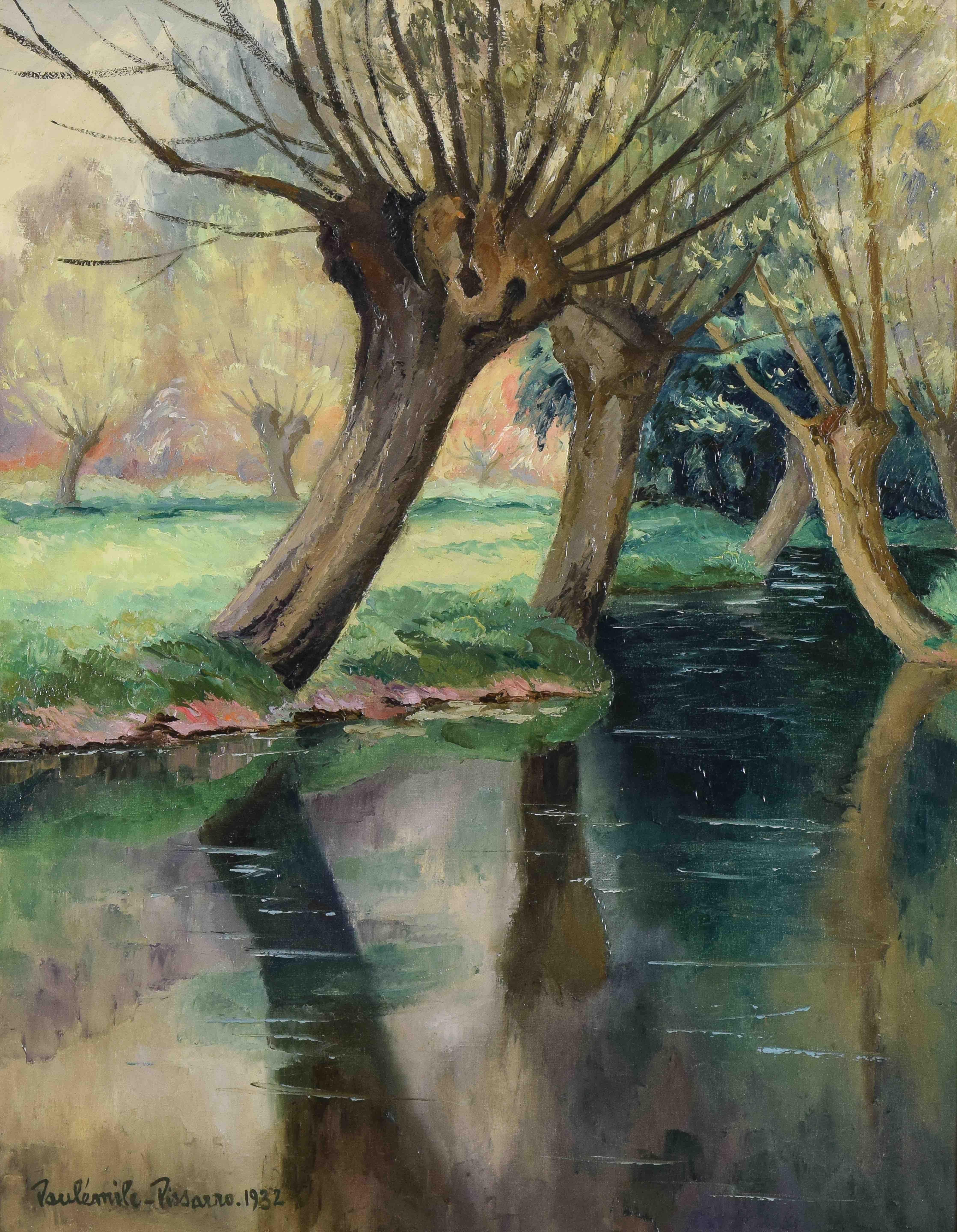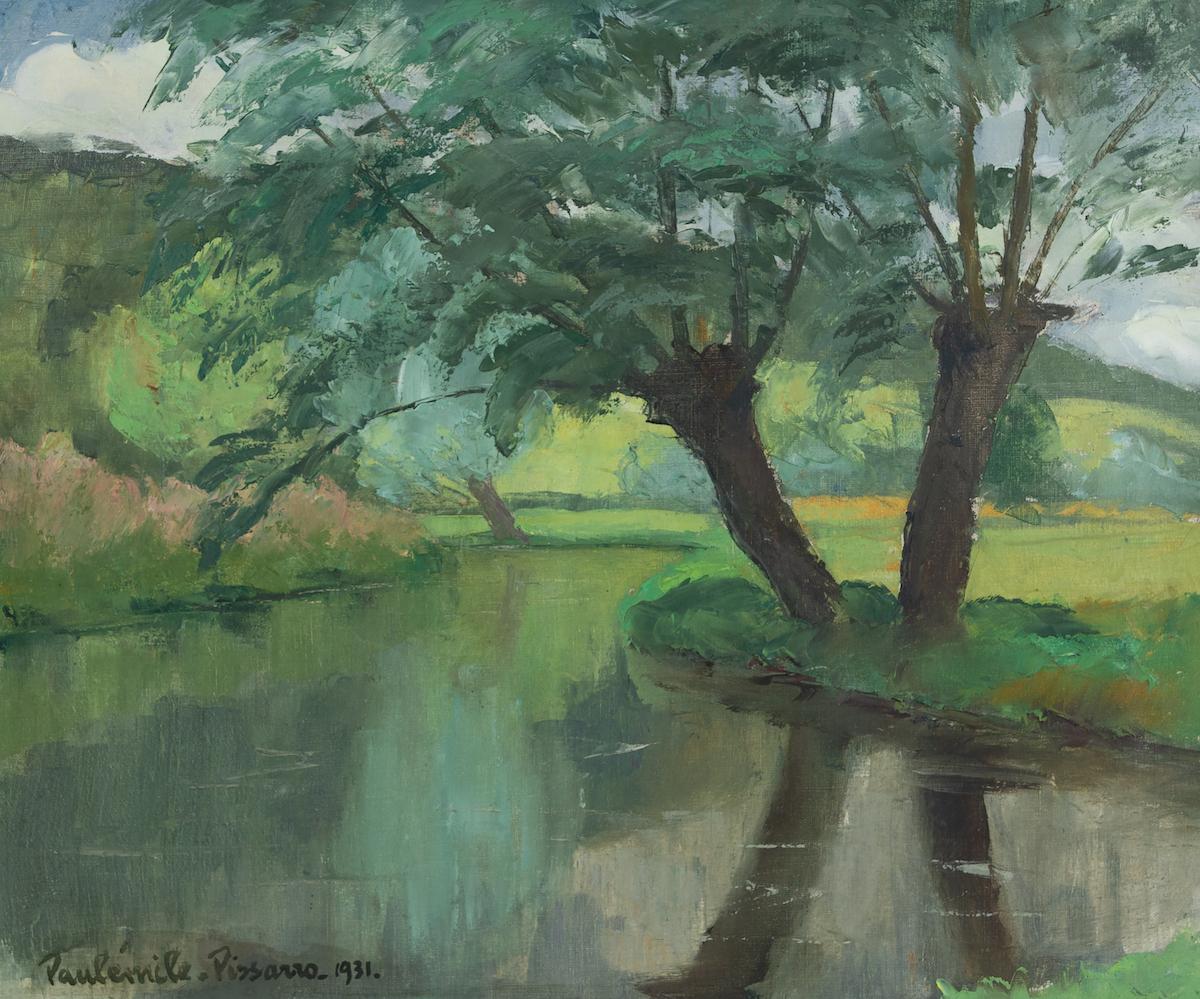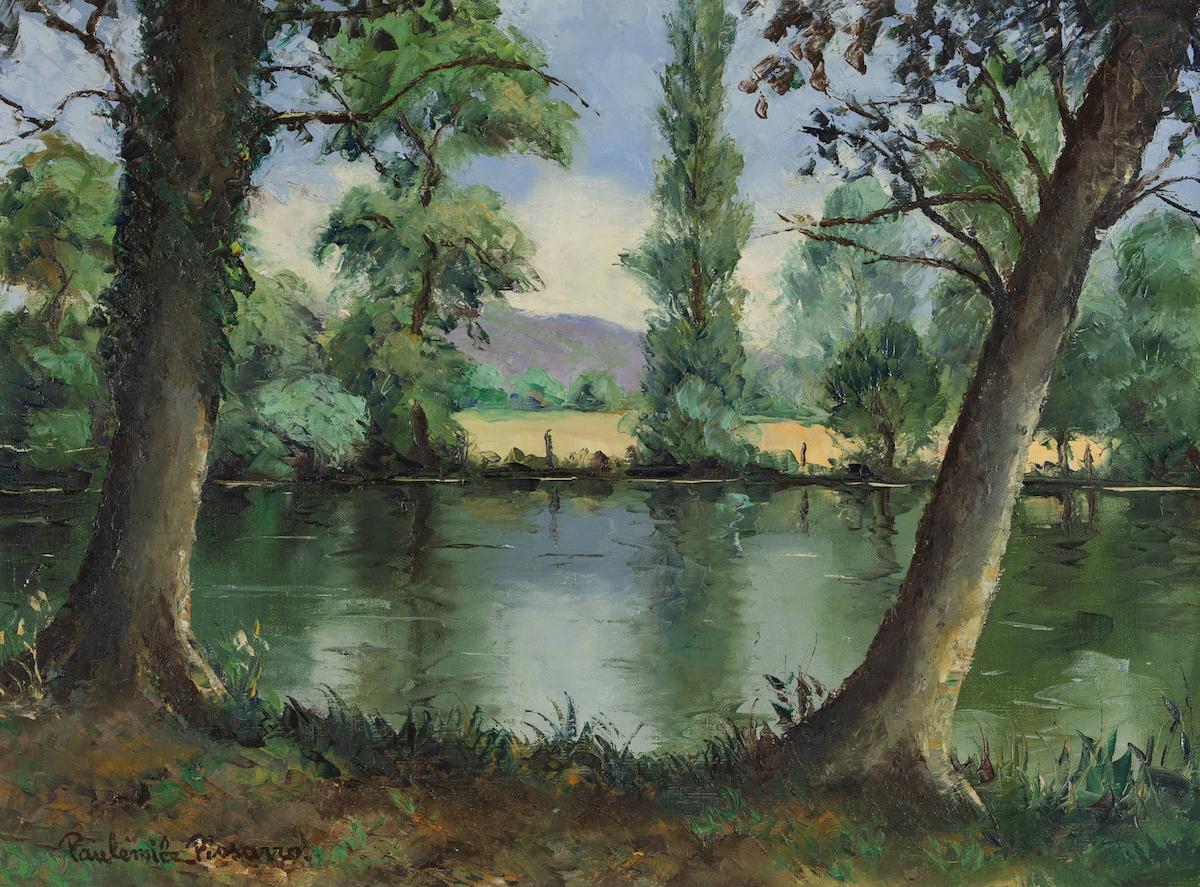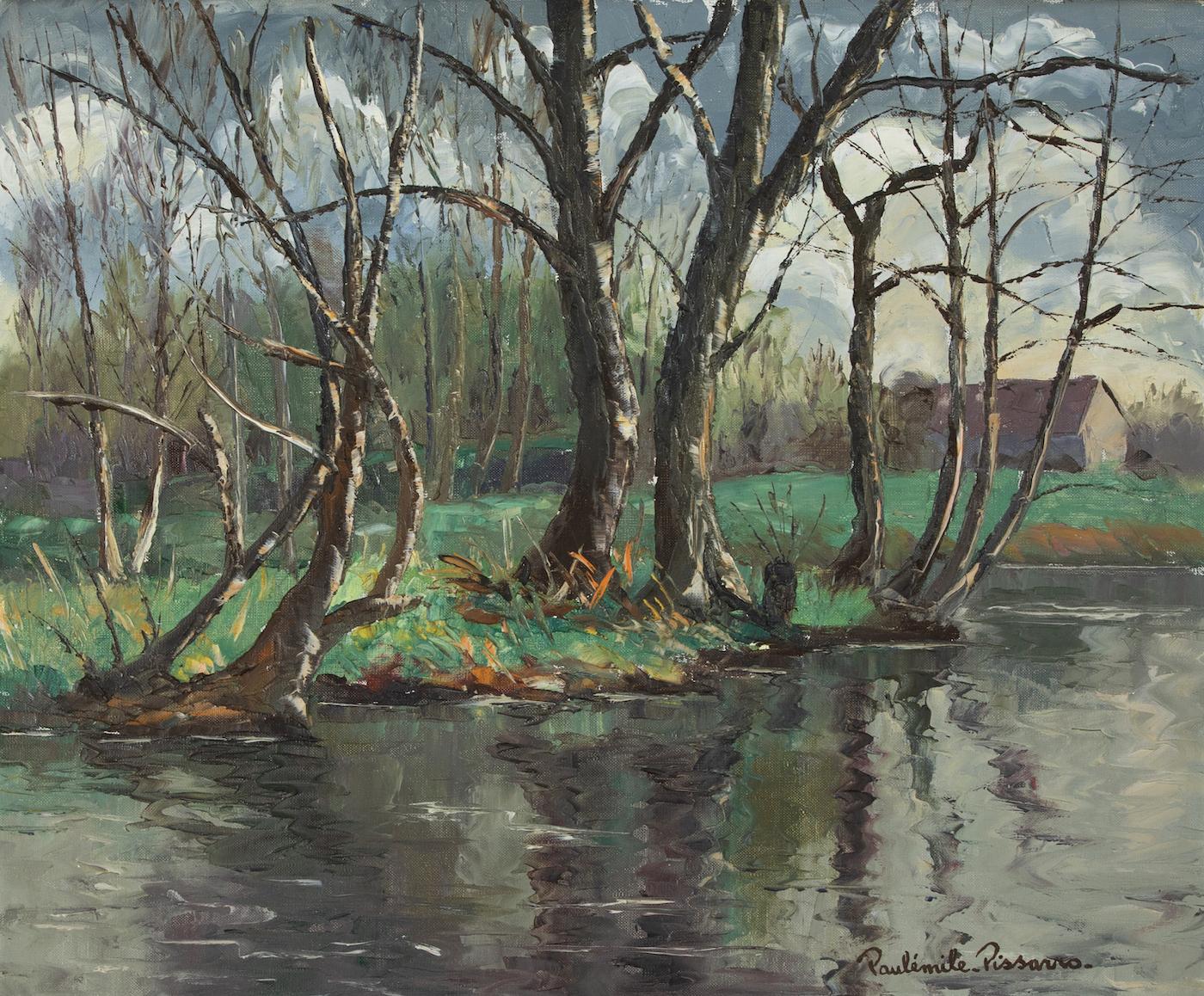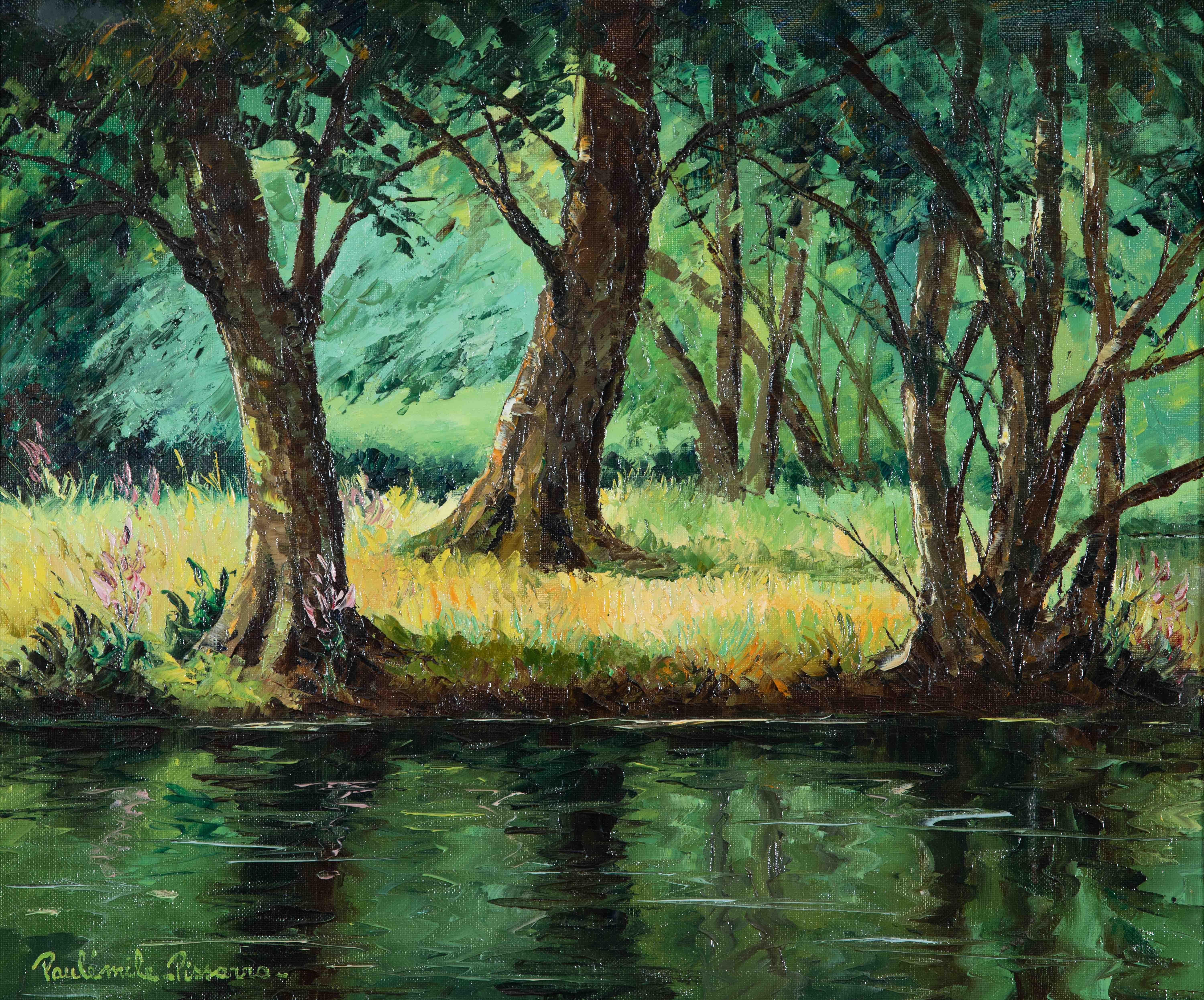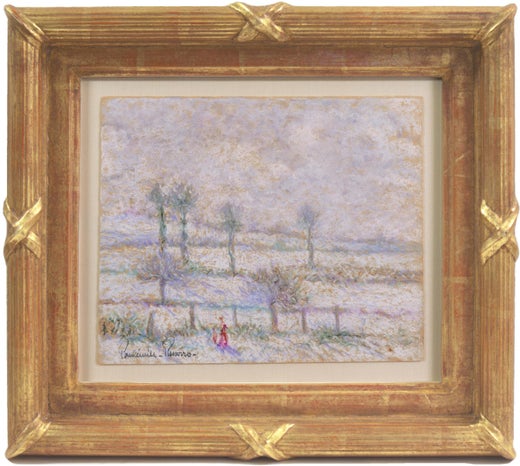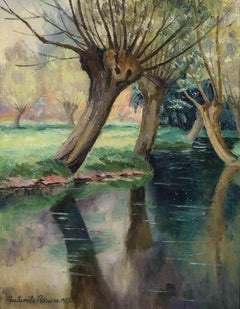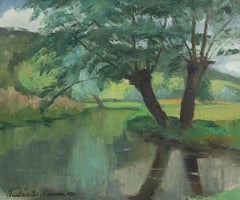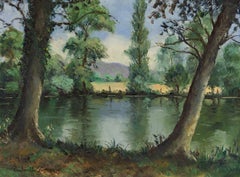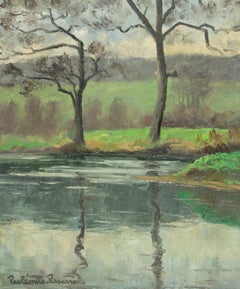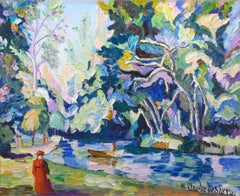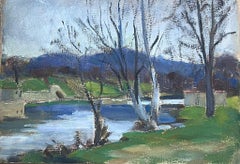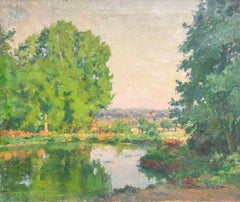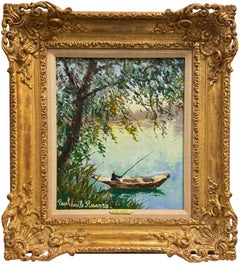Items Similar to L'Arbre au Bord de l'Eau by Paulémile Pissarro - Post-Impressionist river scene
Want more images or videos?
Request additional images or videos from the seller
1 of 12
Paul Emile PissarroL'Arbre au Bord de l'Eau by Paulémile Pissarro - Post-Impressionist river scene1928
1928
$17,500
£13,292.68
€15,317.67
CA$24,644.33
A$27,321.89
CHF 14,358.72
MX$334,375.11
NOK 179,325.79
SEK 168,315.20
DKK 114,336.93
About the Item
L'Arbre au Bord de l'Eau by Paulémile Pissarro (1884-1972)
Oil on canvas
46 x 55 cm (18 ¹/₈ x 21 ⁵/₈ inches)
Signed lower left, Paulémile. Pissarro - 1928.
Executed in 1928
This work is accompanied by a certificate of authenticity by Lélia Pissarro and will be included in the forthcoming catalogue raisonné.
Provenance
Stern Pissarro Gallery, London
Private collection, Austria
Artist biography
Paulémile Pissarro, Camille Pissarro’s youngest son, was born in Éragny in 1884 where he was brought up within the creatively fertile environment of his family home and, encouraged by his father, began drawing at an early age. Paulémile’s godfather was Claude Monet, who became his teacher and legal guardian after Camille’s death in 1903.
In 1905 Paulémile exhibited at the Salon des Indépendants for the first time. Although his father had supported Paulémile’s desire to be an artist, his mother was eager for him to learn a more practical trade. Therefore in 1908 he put aside his artistic pursuits to work as an automobile mechanic and test-driver, then later as a lace and textile designer, allowing him only a limited time to paint. Paulémile only fully dedicated himself to painting following a letter from his brother Lucien in London, who wrote to invite him to take part in an exhibition held in London. Subsequent to the successful sale of a number of watercolours he had sent over, the young artist became inspired to leave the textile factory and pursue a career in art.
By the 1920s Paulémile had become an established Post-Impressionist artist in his own right, spending the summer months escaping from Paris on painting trips with fellow artists Kees Van Dongen, Raoul Dufy, Maurice de Vlaminck and André Dunoyer de Segonzac. In 1922 Paulémile purchased a house in Lyons-la-Forêt, a small village within the region of his hometown of Éragny and Giverny, where he moved in with his first wife Berthe Bennaiche. During this time, he developed a form of Cubism inspired by Paul Cézanne whom he dearly admired, creating some wonderful paintings of the river Eure and its surrounding villages. There he formed a close friendship with his neighbour, the famous Art Deco designer Émile-Jacques Ruhlmann, who designed a stunning Art Deco studio for Paulémile adjacent to his house.
In 1930 he visited and fell in love with the Swiss Normandy area in the Calvados region, in particular the River Orne which runs through the valley adjacent to the villages of Clécy and St. Remy. The combination of rolling hills, bold meadows and the calm river weaving its way through the landscape offered Paulémile a new burst of inspiration. With his second wife Yvonne Beaupel, Paulémile eventually moved to Clécy in 1935, where he would remain for the rest of his life. Of their three children, both H. Claude and Yvon also became artists.
With his house backing on to the river Orne, Paulémile developed a new way of working using a boat as a floating studio, where he spent countless days painting the calm waters from between the riverbanks. Here the influence of his godfather Claude Monet became apparent, particularly in Paulémile’s depiction of water, which was revolutionised by the Impressionist icon. He also applied Monet’s lessons in horticulture to the creation of an abundant garden, offering him many more motifs for his new paintings. Alongside these river landscapes, he also painted the neighbouring hay fields, various snow scenes, some interiors and still lives. The most ambitious work in his oeuvre was a fresco painted on all four walls of his own dining room, depicting the adjacent river in which he includes family members, neighbours and friends.
In 1967 Paulémile had his first one-man show in the United States at Wally Findlay Galleries in New York. This led to widespread recognition and a degree of professional success that few Pissarro artists knew during their lifetime. Since his death in 1972, Paulémile remains one of the best known of Camille’s sons.
- Creator:Paul Emile Pissarro (1884-1972, French)
- Creation Year:1928
- Dimensions:Height: 18.12 in (46 cm)Width: 21.66 in (55 cm)
- Medium:
- Movement & Style:
- Period:
- Condition:
- Gallery Location:London, GB
- Reference Number:1stDibs: LU261213464462
Paul Emile Pissarro
Paul Émile Pissarro (1884–1972) was a French painter and the youngest son of the renowned Impressionist Camille Pissarro. Known as “Paulémile,” he grew up surrounded by artistic innovation and was deeply influenced by his father’s Impressionist style and philosophy. However, he later developed his own artistic voice, primarily within the Post-Impressionist and Fauvist movements. Paulémile’s early artistic training came from his father and contemporaries like Claude Monet and Pierre-Auguste Renoir. This exposure instilled in him a love for plein air painting and the vibrant use of color, traits that became hallmarks of his work. His depictions of rural landscapes, especially those of Normandy and the French countryside, reveal his sensitivity to light, texture, and seasonal changes. While initially working in his family’s tradition, Paulémile gradually incorporated Fauvist influences, embracing bolder, more expressive color palettes. His style also reflected the growing trend toward modernism in the early 20th century. His paintings exhibit a harmony between Impressionist principles and more dynamic, emotive compositions. In addition to painting, Paulémile collaborated with the art dealer Paul Durand-Ruel, whose support solidified his career. Despite his father’s towering legacy, Paulémile maintained a consistent artistic output, earning recognition in his own right through exhibitions in Paris and abroad. Paul Émile Pissarro’s contributions lie in his ability to bridge Impressionism with early modernist sensibilities, ensuring the vitality of landscape painting well into the 20th century. His work continues to be celebrated for its vibrancy and lyrical quality.
About the Seller
5.0
Recognized Seller
These prestigious sellers are industry leaders and represent the highest echelon for item quality and design.
Gold Seller
Premium sellers maintaining a 4.3+ rating and 24-hour response times
Established in 1964
1stDibs seller since 2015
104 sales on 1stDibs
Typical response time: 2 hours
Associations
Society Of London Art Dealers
- ShippingRetrieving quote...Shipping from: London, United Kingdom
- Return Policy
Authenticity Guarantee
In the unlikely event there’s an issue with an item’s authenticity, contact us within 1 year for a full refund. DetailsMoney-Back Guarantee
If your item is not as described, is damaged in transit, or does not arrive, contact us within 7 days for a full refund. Details24-Hour Cancellation
You have a 24-hour grace period in which to reconsider your purchase, with no questions asked.Vetted Professional Sellers
Our world-class sellers must adhere to strict standards for service and quality, maintaining the integrity of our listings.Price-Match Guarantee
If you find that a seller listed the same item for a lower price elsewhere, we’ll match it.Trusted Global Delivery
Our best-in-class carrier network provides specialized shipping options worldwide, including custom delivery.More From This Seller
View AllLa Rivière by PAULÉMILE PISSARRO - Post Impressionist Landscape Painting, River
By Paul Emile Pissarro
Located in London, GB
*UK BUYERS WILL PAY AN ADDITIONAL 20% VAT ON TOP OF THE ABOVE PRICE
La Rivière (The River) by PAULÉMILE PISSARRO (1884-1972)
Oil on canvas
92 x 73 cm (36 1⁄4 x 28 3⁄4 inches)
Signed...
Category
1930s Post-Impressionist Landscape Paintings
Materials
Oil, Canvas
Rivière et Saules by Paulémile Pissarro - Post-Impressionist river scene
By Paul Emile Pissarro
Located in London, GB
Rivière et Saules by Paulémile Pissarro (1884-1972)
Oil on canvas
46.1 x 55.2 cm (18 ¹/₈ x 21 ³/₄ inches)
Signed and dated lower left Paulémile-Pissarro-1931
Titled on the reverse
P...
Category
1930s Post-Impressionist Landscape Paintings
Materials
Canvas, Oil
Bord de l'Orne by Paulémile Pissarro - Post-Impressionist oil river scene
By Paul Emile Pissarro
Located in London, GB
*UK BUYERS WILL PAY AN ADDITIONAL 20% VAT ON TOP OF THE ABOVE PRICE
Bord de l'Orne by Paulémile Pissarro (1884-1972)
Oil on canvas
46 x 61 cm (18 ¹/₈ x 24 inches)
Signed lower left...
Category
1950s Post-Impressionist Landscape Paintings
Materials
Canvas, Oil
Landscape painting by Paulémile Pissarro - 'Les Deux Arbres...'
By Paul Emile Pissarro
Located in London, GB
Les deux arbres au bord de la rivière dans la forêt de Lyons by Paulémile Pissarro (1884-1972)
Oil on canvas
65 x 54 cm (25 ⁵/₈ x 21 ¹/₄ inches)
Signed lower left, Paulémile-Pissarro...
Category
1950s Post-Impressionist Figurative Paintings
Materials
Oil, Canvas
Les Iles à Cantepie by Paulémile Pissarro - River scene painting
By Paul Emile Pissarro
Located in London, GB
*UK BUYERS WILL PAY AN ADDITIONAL 20% VAT ON TOP OF THE ABOVE PRICE
Les Iles à Cantepie by Paulémile Pissarro (1884-1972)
Oil on canvas
54 x 65 cm (21 ¹/₄ x 25 ⁵/₈ inches)
Signed l...
Category
1950s Post-Impressionist Figurative Paintings
Materials
Canvas, Oil
Bord de Riviere Soleil Couchant by Paulémile Pissarro - Landscape, oil painting
By Paul Emile Pissarro
Located in London, GB
Bord de Riviere Soleil Couchant by Paulémile Pissarro (1884-1972)
Oil on canvas
46 x 55 cm (18 ¹/₈ x 21 ⁵/₈ inches)
Signed lower left, Paulémile Pissarro
Signed and titled on the rev...
Category
20th Century Post-Impressionist Landscape Paintings
Materials
Canvas, Oil
You May Also Like
La petite île by H. Claude Pissarro
By Hughes Claude Pissarro
Located in New Orleans, LA
Hugues Claude Pissarro
b.1935 French
La petite île
(The Little Island)
Signed “H. Claude Pissarro” (lower right)
Oil on canvas
In this composition, French artist H. Claude Pissar...
Category
20th Century Post-Impressionist Landscape Paintings
Materials
Canvas, Oil
1930's French Impressionist River Bank Bare Tree Landscape
Located in Cirencester, Gloucestershire
Vintage French Oil Painting
by Louise Alix (French, 1888-1980) *see notes below
provenance stamp to the back
oil painting on board, unframed
measures: 6.75 high by 9.5 inches wide
...
Category
Mid-20th Century Impressionist Landscape Paintings
Materials
Oil
Antique French Impressionist Oil Tranquil Riverbank Scene Luminous Landscape
Located in Cirencester, Gloucestershire
Tranquil Riverbank Scene
first half 20th century
Charles Marvin - Sauvaigo ( 1881 - 1970)
signed oil on canvas, framed
Canvas: 18 x 21.5 inches
Provenance: private collection, Franc...
Category
Mid-20th Century Impressionist Landscape Paintings
Materials
Oil
Pêcheur sur l’étang (Fisherman on the Pond)
Located in Rancho Santa Fe, CA
Signed lower left
Provenance
Wally Findlay Galleries, New York
Private Collection, New York City
This work is available for viewing in our New York City showroom.
Category
20th Century Modern Landscape Paintings
Materials
Canvas, Oil
Lavandieres - Impressionist River Landscape Oil Painting by Maxime Maufra
By Maxime Maufra
Located in Marlow, Buckinghamshire
Signed and dated oil on canvas riverscape painting by French impressionist painter Maxime Maufra. The piece depicts washerwomen on the edge of a river on a sunny spring day washing l...
Category
1880s Impressionist Landscape Paintings
Materials
Canvas, Oil
French Countryside Landscape Oil of Farmhouse Path and Pollarded Trees by River
By Fanch Lel
Located in Cirencester, Gloucestershire
Title: French Countryside Landscape Oil of Farmhouse Path and Pollarded Trees by River
By Fanch Lel
Size: 13.25 x 15.75 inches (height x width)
Oil painting on board, unframed
Condit...
Category
20th Century Impressionist Landscape Paintings
Materials
Oil
More Ways To Browse
Cezanne Paul
Snow River
Art Deco Automobile
Paul Waters
Impressionist Hay
Antique Love Letter
Andre Monet
Pissarro Paul Emile
Yvonne Love
Raoul Dufy Boats
Purple Sunset
54x54 Oil On Canvas Painting
Caribbean Oil Paintings
Oil Landscape Cornwall
Oil Paintings Portugal
19th Century Western Paintings
Anna Masters
Vintage Woodstock
